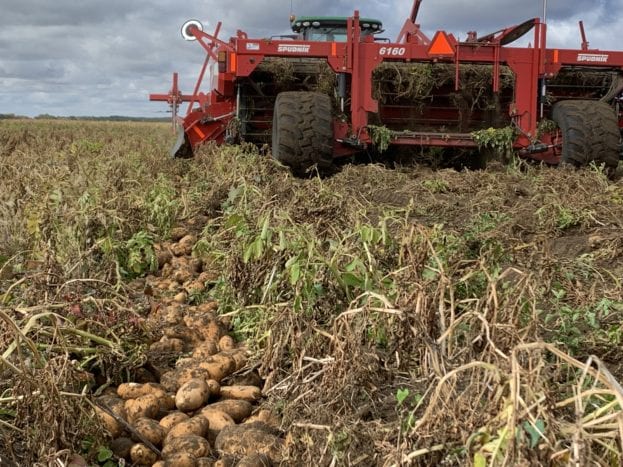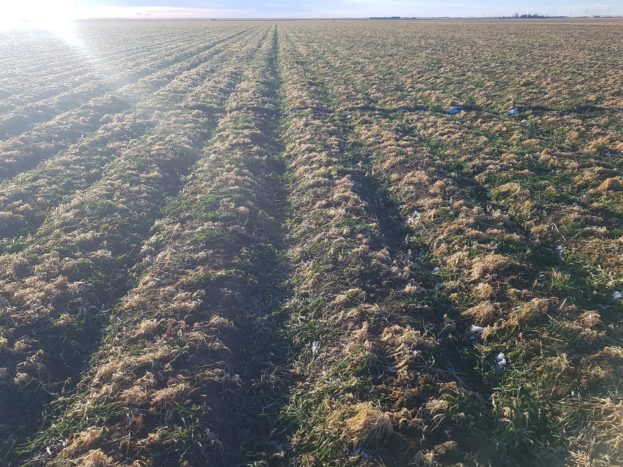A closer look at the impact of regenerative agriculture through minimum tillage in potato production.
During a panel discussion at the 2022 Canadian Spud Congress, three Canadian potato growers discussed how they were reducing tillage in the potato production on their farms. In the session, titled “A Sustainable Future for Potato Production”, they dove into the various ways each of them had developed towards how best to reduce tillage and grow potatoes in a sustainable way. All had been experimenting with this approach for many years, and in some cases even for decades, and had come up with their own ways and adaptations, depending on local conditions and soil.

An important reason for the growers was that minimum tillage is a way to increase the organic matter in their soils. With a healthy soil comes healthy plants, which in turn feed the soil biology below ground. An additional benefit is that with more vigorous plants, with bigger root systems, the carbon sequestration is also increased. Another factor that contributed to potato growers switching to minimum tillage was the constant soil erosion — increasing organic matter in the soil leads to a decrease of wind erosion.
The past year also saw a push for regenerative agriculture in potato production, with big firms such as PepsiCo and McCain Foods releasing pledges for that type of agriculture. For the potato growers these messages were a firm confirmation that their minimum tillage approach is definitely on the right track.

“Those messages were a reinforcement of the value of our approach” says Homer Vander Zaag, potato grower from Alliston, Ont. “It all starts with the soil, and these messages showed that what we’re doing, is in the best interest of the soil.”
According to the growers, the pledges will help convince other farmers and potato growers about the benefits of minimum tillage, although it’ll take a while before other growers are fully up to speed and understand what it does to their soils.

“But we can’t sit still. We have to keep improving,” says Chad Berry, a potato grower from the Cypress Hill region in Manitoba.
The panellists agreed that it typically takes many years before a potato grower arrives at a point where they feel confident about the minimum tillage approach. And not to forget the investment that’s needed to make the change. And this is where the field days come in, where other potato growers can visit minimum tillage potato farms. They get to see with their own eyes how it’s done and can ask questions.
“Farmers ask how best to do the fall ridging, and how to plant the potatoes in spring, with all the plant debris on and in the soil,” says Harold Perry, potato grower from the Chin, Alta.

At the moment there’s only a small percentage of the Canadian potato growers that are applying minimum tillage in their potato production, whereas a large majority of those farmers already use cover cropping on their farms, which is a good start towards minimum tillage. Most of the cover crops being grown are cereals, with very few in the pulse crop family. An increasing trend is the use of multi-species cover crops, which has really taken off in the past two to three years.
“We are sowing winter wheat together with red clover, and this adds a good amount of biomass, but also an extra 50 to 70 units of nitrogen to the soil, which is then available for the next crop,” explains Vander Zaag.

A major advantage of using cover crops in a minimum tillage setting is that the water holding capacity of the soil increases drastically. Some studies show a fivefold increase in that capacity.
In 2021, certain areas saw an exceptionally dry spring, whereas June and July were the opposite, followed again by very dry and wet periods. In such unpredictable situations, good and healthy soil can contribute positively to having a good harvest at the end of the season. For the extreme dry periods, the potato growers used irrigation where possible, but with the extreme drought, the irrigation systems were stretched to the limit.
The potato growers on the panel also had some advice for other growers who are considering switching to minimum tillage.
“Don’t be afraid to try. You will make mistakes and you are going to mess up. Start small and keep trying and keep pushing. It will pay off,” says Berry.
The growers are also convinced that a minimum tillage approach leads to a lower disease pressure in their potato fields. It’s a fine line the growers are walking, as each crop protection product also hurts beneficial organisms. The more organic matter and beneficial organisms there are in the soil, the more resilient a field gets to withstand fluctuations.
Related Articles
The Regenerative Ag Debate for Growing Potatoes, is it Possible?








